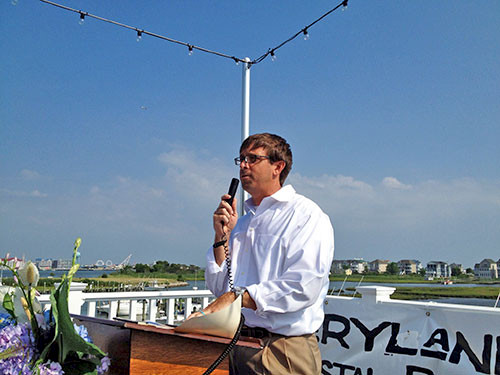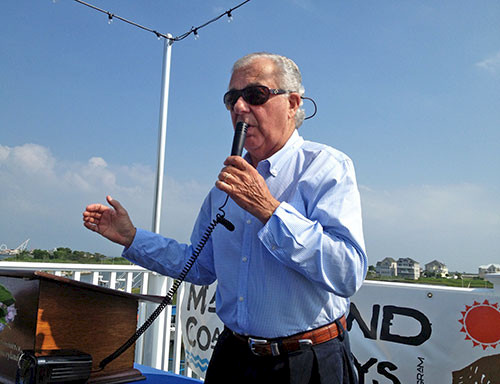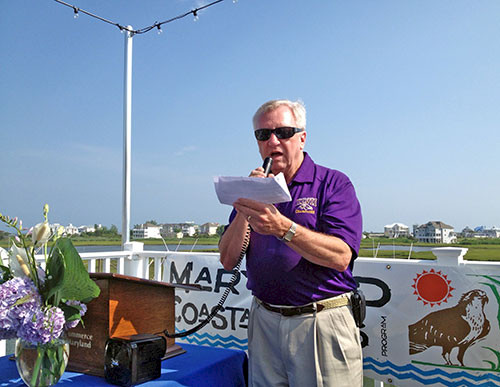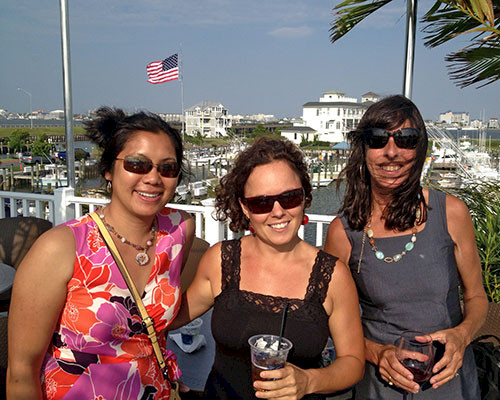Coastal Bays report card launch
Bill Dennison ·The Maryland Coastal Bays report card launch was held on 27 June 2013, on a Mickey Fins balcony overlooking the Coastal Bays waterways. It was a gorgeous day with a nice breeze and stupendous views. Dave Wilson, the Executive Director of the Maryland Coastal Bays Program, was the Master of Ceremonies for the report card launch. Bud Church, President of Worcester County Commission, welcomed everyone and acknowledged the elected officials in attendance. 'Gee' Williams, Mayor of the Town of Berlin, proclaimed the completion of the removal of sewage discharge into Newport Bay as a result of a treatment and spray irrigation system. Steve Taylor, the first Executive Director of the Maryland Coastal Bays Program now serving as Chair of the Citizens Advisory Committee, presented the 'Golden Osprey' award to Bob Abele, a retired engineer who has donated considerable time to the Coastal Bays.

In discussing the report card, my remarks were the following:
The overall 2012 Maryland Coastal Bays report card score was a C+, up from a C last year. The best score was Sinepuxent Bay and the worst score was Newport Bay. What we have been seeing the past few years is improving water quality north of the Ocean City inlet (Isle of Wight Bay, Assawoman Bay, St. Martin River) and declining water quality south of the inlet (Chinoteague, Sinepuxent and Newport Bays). Chincoteague Bay has historically been our jewel of the East coast, with improving conditions and expanding seagrasses throughout the 1990s. However, seagrasses are now declining in Chincoteague Bay, but the good news is that water quality was up a bit last year. The seagrass story is not just water quality, it also involves climate variability. We have had some very hot summers which are essentially 'cooking' the seagrass.
Everyone here who suffered through Superstorm Sandy is aware of climate extremes. We really dodged a bullet with Sandy, but we are not always going to be this fortunate and we need to be prepared for a direct hit sometime in the future. We need to be mindful that all the protection and restoration activities we do in the Coastal Bays helps create resilient ecosystems that can withstand the impact of large events like Sandy.

We are celebrating our ten year anniversary of a strong science partnership between the University of Maryland Center for Environmental Science, Maryland Coastal Bays Program, Maryland Department of Natural Resources, and Assateague National Seashore. This partnership has produced products like the book "Shifting Sands: Environmental and cultural change in Maryland's Coastal Bays", the annual report cards and various synthesis papers.
We have also targeted research to address key issues in the Coastal Bays, like the enigmatic recent degradation in Chincoteague Bay. We discovered three nutrient sources that potentially impact water quality of Chincoteague Bay. One source is the thousands of septic systems on Chincoteague Island that leach nutrients through the sandy soils directly into Chincoteague Bay. They really need to install a modern sewage treatment facility for Chincoteague Island. Another source that we have identified comes from the rather small watershed of Chincoteague Bay. We have found groundwater seeps that enter the streams of Chincoteague Bay with extremely high concentrations of dissolved nitrate and phosphate. Phosphate does not usually travel in groundwater due to its adherence to soil particles. But the soils are apparently saturated with phosphate and it is now mobile in groundwater, and both nitrate and phosphate are entering Chincoteague Bay through these groundwater seeps. The other surprise that we discovered was a large nutrient and phytoplankton plume down-current from the offshore Ocean City sewage treatment plant outfall. We haven't measured the influx of this plume into the Coastal Bays through the Ocean City inlet yet, but we know from other Atlantic Ocean coastal lagoons that meteorological tides can entrain offshore waters into the lagoons, thus providing another potential source of nutrients. In summary, Chincoteague Bay is getting nutrients from the island, the watershed and the Ocean City outfall.

I want to make a point regarding our vulnerability to change change in this fantastic ecosystem. Yesterday, the report "Updating Maryland's Sea-level Rise Projections", produced by a team of 14 scientists led by Dr. Don Boesch was released. This report provides the sobering projection that sea level may rise two feet by 2050. This level of sea level rise will inundate salt marshes and put significant infrastructure in the Coastal Bays at risk. We are going to have to be cognizant of various climate change impacts - like inundation due to sea level rise, high temperatures that kill seagrasses, and extreme storms like Hurricane Sandy that can impact the Coastal Bay habitats. We need to maintain healthy ecosystems to maximize resilience to climate change.

In conclusion, the Coastal Bays are fairly intact ecosystems with abundant marshes and seagrass meadows, colonial waterbirds, fish and shellfish. The Coastal Bays also support rare, threatened and endangered plants and animals, which actually benefit from overwash events due to Hurricane Sandy. I would like to thank Dave Wilson for this opportunity to talk about the report card, and Jane Thomas for producing the report card trifold and supporting web content. I applaud the combined efforts of the Maryland Coastal Bays Program, Ocean City and Worcester County officials, and the people gathered here who work so hard to protect this treasured ecosystem. The 'Forgotten Bays' have been discovered and I can see this C+ report card headed toward improved grades - I look forward to the day when we can see the Coastal Bays receive an A.

About the author
Bill Dennison

Dr. Bill Dennison is a Professor of Marine Science and Interim President at the University of Maryland Center for Environmental Science (UMCES).